2006 SUBARU IMPREZA window
[x] Cancel search: windowPage 4 of 365
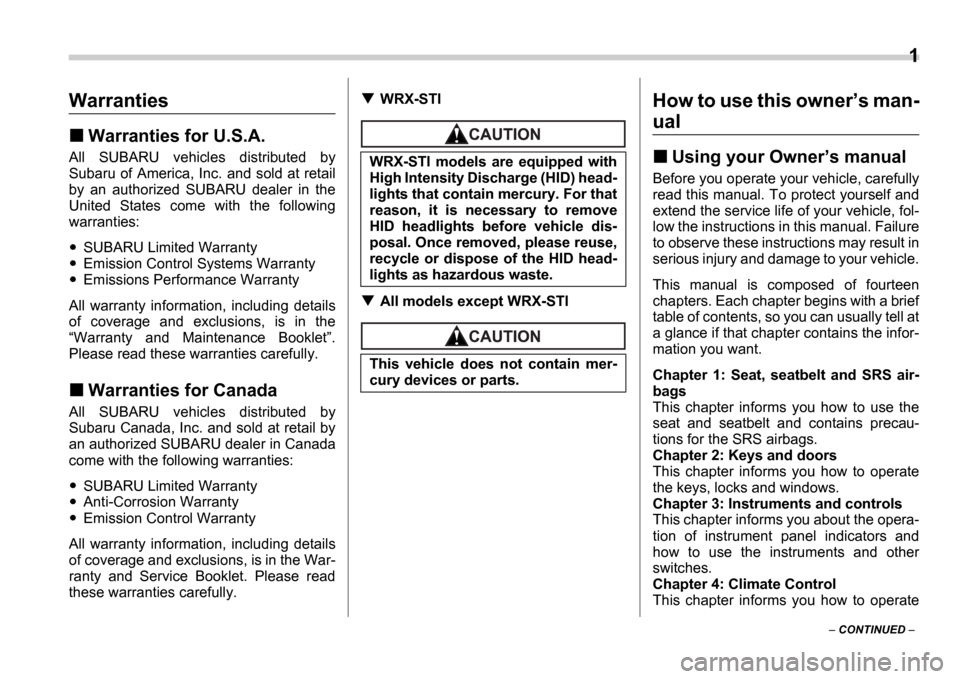
1
CONTINUED
Warranties
Warranties for U.S.A.
All SUBARU vehicles distributed by
Subaru of America, Inc. and sold at retail
by an authorized SUBARU dealer in the
United States come with the following
warranties:
SUBARU Limited Warranty
Emission Control Systems Warranty
Emissions Performance Warranty
All warranty information, including details
of coverage and exclusions, is in the Warranty and Maintenance Booklet .
Please read these warranties carefully.
Warranties for Canada
All SUBARU vehicles distributed by
Subaru Canada, Inc. and sold at retail by
an authorized SUBARU dealer in Canada
come with the following warranties:
SUBARU Limited Warranty
Anti-Corrosion Warranty
Emission Control Warranty
All warranty information, including details
of coverage and exclusions, is in the War-
ranty and Service Booklet. Please read
these warranties carefully.
WRX-STI
All models except WRX-STI
How to use this owner s man-
ual
Using your Owner s manual
Before you operate your vehicle, carefully
read this manual. To protect yourself and
extend the service life of your vehicle, fol-
low the instructions in this manual. Failure
to observe these instructions may result in
serious injury and damage to your vehicle.
This manual is composed of fourteen
chapters. Each chapter begins with a brief
table of contents, so you can usually tell at
a glance if that chapter contains the infor-
mation you want.
Chapter 1: Seat, seatbelt and SRS air-
bags
This chapter informs you how to use the
seat and seatbelt and contains precau-
tions for the SRS airbags.
Chapter 2: Keys and doors
This chapter informs you how to operate
the keys, locks and windows.
Chapter 3: Instruments and controls
This chapter informs you about the opera-
tion of instrument panel indicators and
how to use the instruments and other
switches.
Chapter 4: Climate Control
This chapter informs you how to operate
WRX-STI models are equipped with
High Intensity Discharge (HID) head-
lights that contain mercury. For that
reason, it is necessary to remove
HID headlights before vehicle dis-
posal. Once removed, please reuse,
recycle or dispose of the HID head-
lights as hazardous waste.
This vehicle does not contain mer-
cury devices or parts.
Page 6 of 365

3
CONTINUED
Vehicle symbols
There are some of the symbols you may
see on your vehicle.
Mark Name
CAUTION
Power door lock and unlock
Passengers windows lock
and unlock
Fuel
Front fog lights
Parking lights
Hazard warning flasher
Cigarette lighter
Engine hood
Trunk lid (Sedan)
Seat heater
Child restraint top tether an-
chorages
Child restraint lower anchor-
ages
Horn
Windshield wiper deicer
Wiper intermittent
Windshield wiper and wash-
er
Rear window wiper and
washer
Lights
Parking lights, tail lights, li-
cense plate light and instru-
ment panel illumination
Mark NameHead lights
Headlight beam leveler
Illumination brightness
Fan speed
Instrument panel outlets
Instrument panel outlets and
foot outlets
Foot outlets
Windshield defroster and
foot outlets
Windshield defroster
Rear window defogger/Out-
side mirror defogger
Air recirculation
Outside air
Mark Name
Page 8 of 365
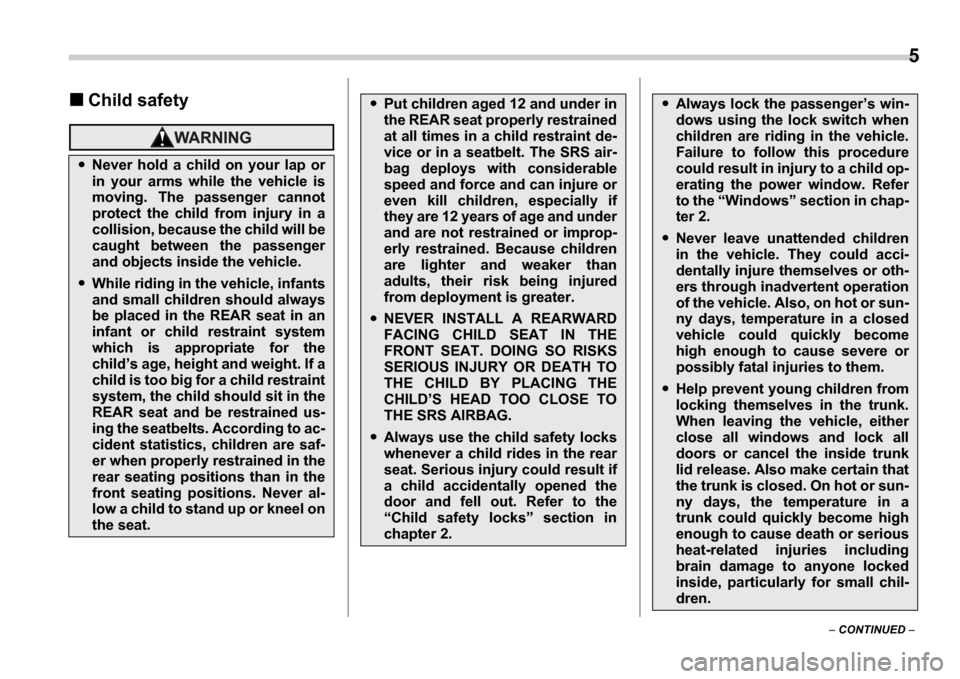
5
CONTINUED
Child safety
Never hold a child on your lap or
in your arms while the vehicle is
moving. The passenger cannot
protect the child from injury in a
collision, because the child will be
caught between the passenger
and objects inside the vehicle.
While riding in the vehicle, infants
and small children should always
be placed in the REAR seat in an
infant or child restraint system
which is appropriate for the
childs age, height and weight. If a
child is too big for a child restraint
system, the child should sit in the
REAR seat and be restrained us-
ing the seatbelts. According to ac-
cident statistics, children are saf-
er when properly restrained in the
rear seating positions than in the
front seating positions. Never al-
low a child to stand up or kneel on
the seat.
Put children aged 12 and under in
the REAR seat properly restrained
at all times in a child restraint de-
vice or in a seatbelt. The SRS air-
bag deploys with considerable
speed and force and can injure or
even kill children, especially if
they are 12 years of age and under
and are not restrained or improp-
erly restrained. Because children
are lighter and weaker than
adults, their risk being injured
from deployment is greater.
NEVER INSTALL A REARWARD
FACING CHILD SEAT IN THE
FRONT SEAT. DOING SO RISKS
SERIOUS INJURY OR DEATH TO
THE CHILD BY PLACING THE
CHILD S HEAD TOO CLOSE TO
THE SRS AIRBAG.
Always use the child safety locks
whenever a child rides in the rear
seat. Serious injury could result if
a child accidentally opened the
door and fell out. Refer to the Child safety locks section in
chapter 2.
Always lock the passenger s win-
dows using the lock switch when
children are riding in the vehicle.
Failure to follow this procedure
could result in injury to a child op-
erating the power window. Refer
to the Windows section in chap-
ter 2.
Never leave unattended children
in the vehicle. They could acci-
dentally injure themselves or oth-
ers through inadvertent operation
of the vehicle. Also, on hot or sun-
ny days, temperature in a closed
vehicle could quickly become
high enough to cause severe or
possibly fatal injuries to them.
Help prevent young children from
locking themselves in the trunk.
When leaving the vehicle, either
close all windows and lock all
doors or cancel the inside trunk
lid release. Also make certain that
the trunk is closed. On hot or sun-
ny days, the temperature in a
trunk could quickly become high
enough to cause death or serious
heat-related injuries including
brain damage to anyone locked
inside, particularly for small chil-
dren.
Page 14 of 365
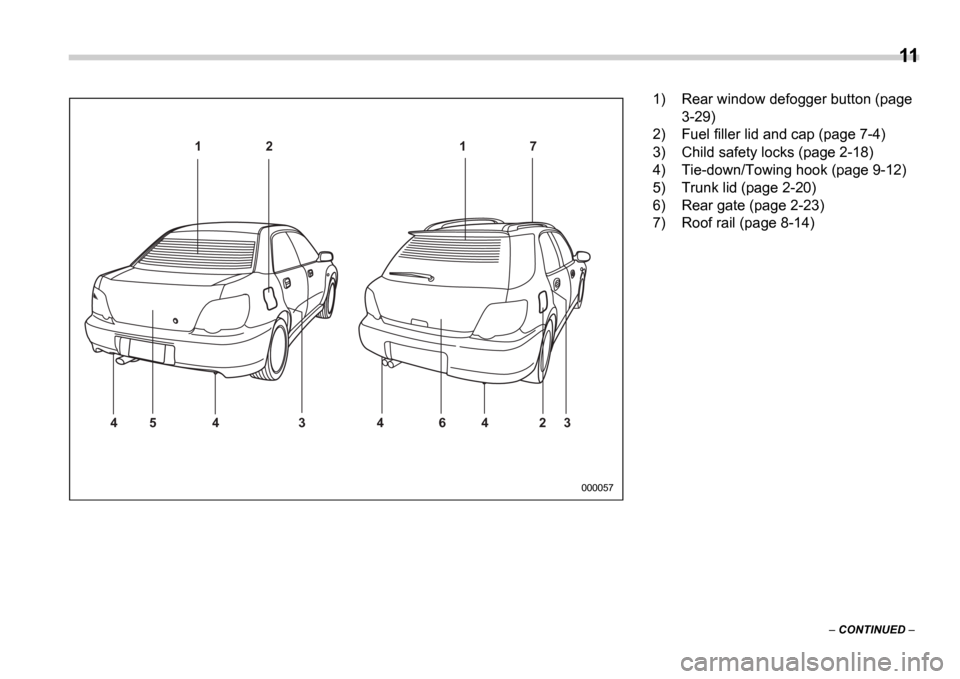
11
CONTINUED
1 2
3 4 4 6 2 3
4
4 5 1 7
000057
1) Rear window defogger button (page
3-29)
2) Fuel filler lid and cap (page 7-4)
3) Child safety locks (page 2-18)
4) Tie-down/Towing hook (page 9-12)
5) Trunk lid (page 2-20)
6) Rear gate (page 2-23)
7) Roof rail (page 8-14)
Page 17 of 365

14
Instrument panel
7
6
5
4
3
2
1
15
16 14 12 10 11
13 9 8
000188
1) Door locks (page 2-4)
2) Outside mirror switch (page 3-34)
3) Light control lever (page 3-22)
4) Combination meter (page 3-11)
5) Wiper control lever (page 3-26)
6) Hazard warning flasher switch (page
3-6)
7) Audio (page 5-1)
8) Gear shift lever (5MT) (page 7-11)/
Gear shift lever (6MT) (page 7-9)/Se-
lector lever (AT) (page 7-16)
9) Climate control (page 4-1)
10) Cruise control (page 7-27)
11) Horn (page 3-35)
12) SRS airbag (page 1-35)
13) Tilt steering (page 3-35)
14) Fuse box (page 11-41)
15) Hood lock release knob (page 11-4)
16) Power windows (page 2-18)
Page 18 of 365
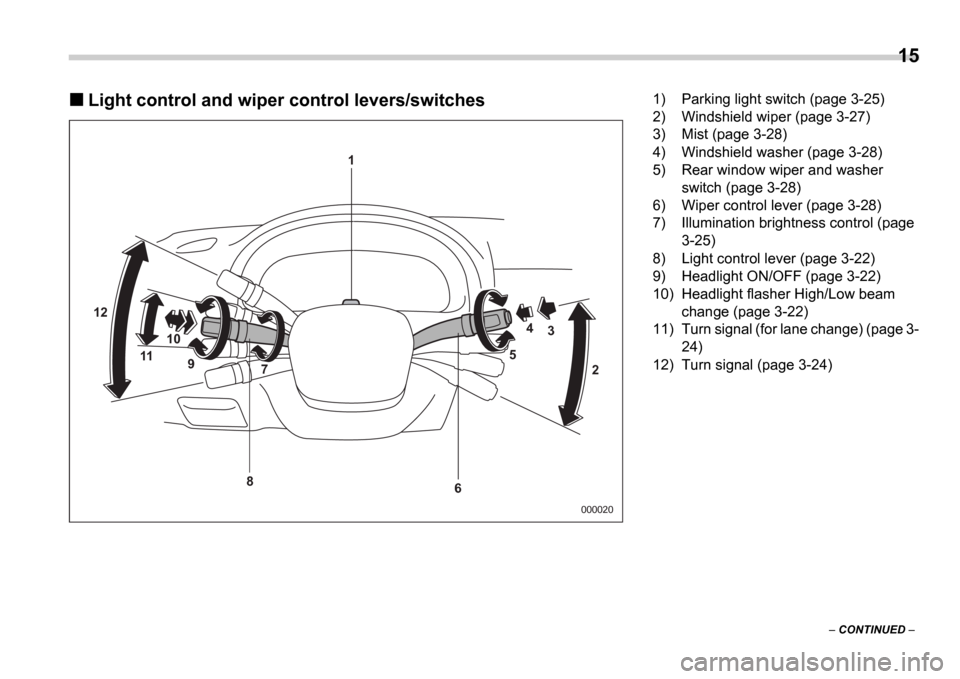
15
CONTINUED
Light control and wiper control levers/switches
000020
12
3
4
5
1
10 9 7
11
2
6
8
1) Parking light switch (page 3-25)
2) Windshield wiper (page 3-27)
3) Mist (page 3-28)
4) Windshield washer (page 3-28)
5) Rear window wiper and washer
switch (page 3-28)
6) Wiper control lever (page 3-28)
7) Illumination brightness control (page 3-25)
8) Light control lever (page 3-22)
9) Headlight ON/OFF (page 3-22)
10) Headlight flasher High/Low beam change (page 3-22)
11) Turn signal (for lane change) (page 3-
24)
12) Turn signal (page 3-24)
Page 37 of 365

1-10 Seat, seatbelt and SRS airbags
Your vehicle is equipped with a crash
sensing and diagnostic module, which will
record the use of the seatbelt(s) by the
driver and front passenger when any of
the SRS frontal and side airbags deploys.
Infants or small children
Use a child restraint system that is suit-
able for your vehicle. See information on Child restraint systems in this chapter.
Children
If a child is too big for a child restraint sys-
tem, the child should sit in the rear seat
and be restrained using the seatbelts. Ac- cording to accident statistics, children are
safer when properly restrained in the rear
seating positions than in the front seating
positions. Never allow a child to stand up
or kneel on the seat.
If the shoulder portion of the belt crosses
the face or neck, adjust the shoulder belt
anchor height (window-side seating posi-
tions only) and then if necessary move the
child closer to the belt buckle to help pro-
vide a good shoulder belt fit. Care must be
taken to securely place the lap belt as low
as possible on the hips and not on the
child
s waist. If the shoulder portion of the
belt cannot be properly positioned, a child
restraint system should be used. Never
place the shoulder belt under the child s
arm or behind the child s back.
Put children aged 12 and under in
the rear seat properly restrained
at all times. The SRS airbag de-
ploys with considerable speed
and force and can injure or even
kill children, especially if they are
12 years of age and under and are
not restrained or improperly re-
strained. Because children are
lighter and weaker than adults,
their risk of being injured from de-
ployment is greater. Consequent-
ly, we strongly recommend that
ALL children (including those in
child seats and those that have
outgrown child restraint devices)
sit in the REAR seat properly re-
strained at all times in a child re-
straint device or in a seatbelt,
whichever is appropriate for the
child s height and weight.
Secure ALL types of child re-
straint devices (including forward
facing child seats) in the REAR
seats at all times.
NEVER INSTALL A REARWARD
FACING CHILD SEAT IN THE
FRONT SEAT. DOING SO RISKS
SERIOUS INJURY OR DEATH TO
THE CHILD BY PLACING THE
CHILD S HEAD TOO CLOSE TO
THE SRS AIRBAG.
According to accident statistics,
children are safer when properly
restrained in the rear seating posi-
tions than in the front seating po-
sitions. For instructions and pre-
cautions concerning the child re-
straint system, see the Child re-
straint systems section in this
chapter.
Page 42 of 365
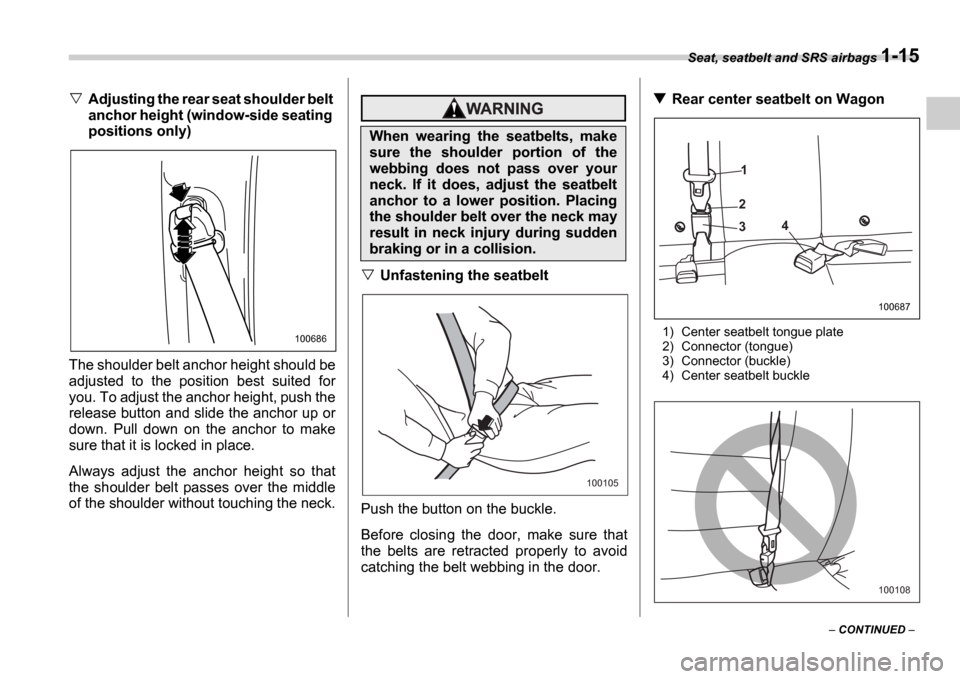
Seat, seatbelt and SRS airbags 1-15
CONTINUED
Adjusting the rear seat shoulder belt
anchor height (window-side seating
positions only)
The shoulder belt anchor height should be
adjusted to the position best suited for
you. To adjust the anchor height, push the
release button and slide the anchor up or
down. Pull down on the anchor to make
sure that it is locked in place.
Always adjust the anchor height so that
the shoulder belt passes over the middle
of the shoulder without touching the neck.
Unfastening the seatbelt
Push the button on the buckle.
Before closing the door, make sure that
the belts are retracted properly to avoid
catching the belt webbing in the door.
Rear center seatbelt on Wagon
1) Center seatbelt tongue plate
2) Connector (tongue)
3) Connector (buckle)
4) Center seatbelt buckle100686
When wearing the seatbelts, make
sure the shoulder portion of the
webbing does not pass over your
neck. If it does, adjust the seatbelt
anchor to a lower position. Placing
the shoulder belt over the neck may
result in neck injury during sudden
braking or in a collision.
100105
3 4
1
2
100687
100108